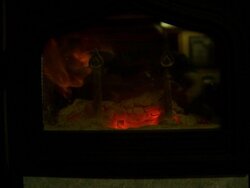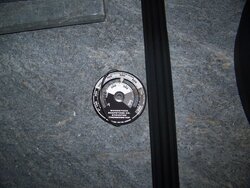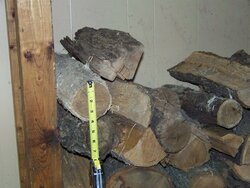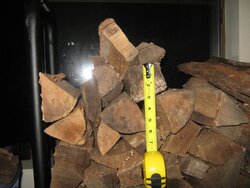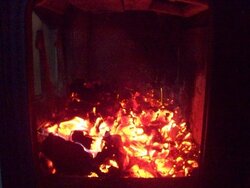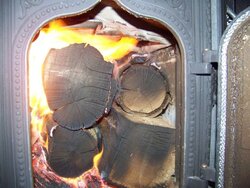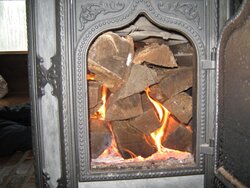There have been a few member posts lately about how hot and how long their Fireviews were burning so I thought I'd share mine.
It was loaded with 100% made in USA Red Oak, seasoned 2.5 years, top covered the last 6 months.
I think I could have cleaned more ash out and fit 2-3 more small splits if I tried. The splits were all 16", split small (3" to 5").
The front temp was measured in the upper right corner of the cast iron trim.
Time Front Temp. Stovetop Temp. Room temp Outside Temp
0 Hrs 250F 290F 67.1F 24F Load, engage cat in 15 minutes, set draft=1.0
1 Hr 490 550F 68.2 26 Excellent secondaries, dropped draft to 0.75
2 Hr 450 520 69.6 27 Secondaries Quit
3 Hr 400 440 70.3 28 Set Draft to 1.5
4 Hr 395 400 70.7 27
5 Hr 340 360 69.5 24
6 Hr 290 300 69.1 23 Set Draft to 3
6.5 Hr 280 290 68.5 22 Reload Time!
I have gone 10 hrs using Oak, but the draft was set to 0.5 the entire time and the final stovetop temp was 250F.
It was loaded with 100% made in USA Red Oak, seasoned 2.5 years, top covered the last 6 months.
I think I could have cleaned more ash out and fit 2-3 more small splits if I tried. The splits were all 16", split small (3" to 5").
The front temp was measured in the upper right corner of the cast iron trim.
Time Front Temp. Stovetop Temp. Room temp Outside Temp
0 Hrs 250F 290F 67.1F 24F Load, engage cat in 15 minutes, set draft=1.0
1 Hr 490 550F 68.2 26 Excellent secondaries, dropped draft to 0.75
2 Hr 450 520 69.6 27 Secondaries Quit
3 Hr 400 440 70.3 28 Set Draft to 1.5
4 Hr 395 400 70.7 27
5 Hr 340 360 69.5 24
6 Hr 290 300 69.1 23 Set Draft to 3
6.5 Hr 280 290 68.5 22 Reload Time!
I have gone 10 hrs using Oak, but the draft was set to 0.5 the entire time and the final stovetop temp was 250F.


